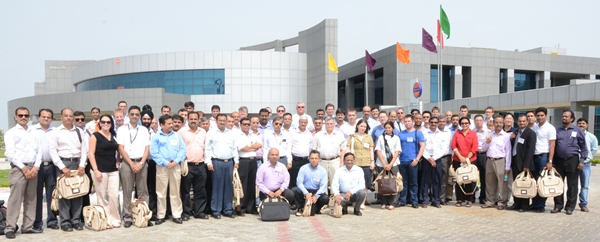IRPC ’13: Indian Oil shows off Panipat complex
7/9/2013 12:00:00 AM
Online Editor
 PANIPAT, India -- The fourth annual International Refining & Petrochemical Conference (IRPC) kicked off Tuesday with a tour of Indian Oil’s prized Panipat refinery and petrochemicals complex in northern India.
PANIPAT, India -- The fourth annual International Refining & Petrochemical Conference (IRPC) kicked off Tuesday with a tour of Indian Oil’s prized Panipat refinery and petrochemicals complex in northern India.Though the conference itself opens Wednesday in New Delhi, about 80 attendees also registered to attend the precursor event, which gives delegates an in-depth look at one of the industry’s top facilities.
Delegates were bused about 100 kilometers north of New Delhi to visit the Panipat facility, which is among the largest integrated complexes in Asia. It has 300,000 bpd of refining capacity, 800,000 tpy of ethylene output and numerous derivative and secondary processing units.
“The tour is always exciting because it gives guests the chance to actually see a facility that already has a reputation,” said John Royall, CEO of Gulf Publishing Company, which organized the event alongside host Indian Oil.
“They get to see first hand what makes these facilities tick, and it gives them new ideas and perspectives,” he added.
Panipat became the 7th refinery of Indian Oil when it started operations in 1998, with an initial installed capacity of 6.0 million tons per annum (MMTPA). That has since been expanded to 15.0 MMTPA, with secondary units such as the catalytic reforming unit, once-through hydrocracker unit, resid fluidized catalytic cracking unit, visbreaker unit, bitumen blowing unit and a sulfur block.
But by the early 2000s, the company began to see margins squeezed within its fuels businesses, according to Indian Oil’s S.N, Vaidya, deputy general manager of technical services at Panipat. Vaidya gave the keynote presentation at Tuesday’s event.
In turn, Indian Oil turned to petrochemicals in recent years, crafting both an aromatics complex (PX, PTA) as well as an olefins complex. The latter facility was based on the 800,000 tpy naphtha cracker, which launched in March 2010 and is currently India’s largest operating cracker.
Vaidya explained that a large part of Indian Oil’s success comes from its integrated operating strategy. For example, the naphtha feedstock for the cracker is sourced internally from Indian Oil’s Gujarat, Panipat and Mathura refineries.
Other petrochemicals units include a 350,000 tpy LLDPE/HDPE swing unit, two 300,000 tpy polypropylene (PP) plants, a 300,000 tpy HDPE unit and a 300,000 tpy monoethylene glycol (MEG) plant.
IRPC delegates were given an up-close look at all of those and more on Tuesday, with Indian Oil shuttling two trams full of industry professionals -- including 20 foreign nationals -- directly through the complex.
Better yet, the engineer-heavy crowd was escorted into the main control rooms of both the refinery and petrochemical complexes, allowing a thorough examination of the site’s impressive process control.
“It was a lot of fun,” said Mayur Ingole, a delegate from Sulzer Chemtech who works as a business development manager for the company. “Very impressive.”
For more information on the Panipat complex, visit Indian Oil’s website.
The conference portion of IRPC occurs Wednesday and Thursday at the Taj Palace in New Delhi, with hundreds of delegates scheduled to attend and network while listening to presentations from some of the industry’s top executives. Stay tuned to HydrocarbonProcessing.com for further coverage.







Comments